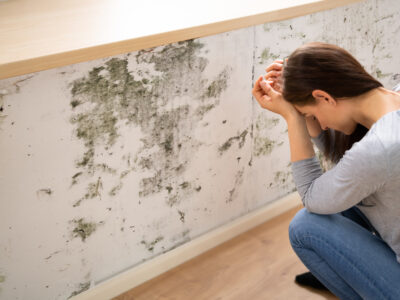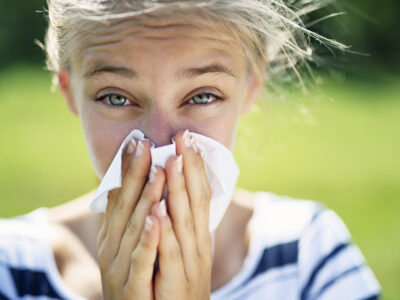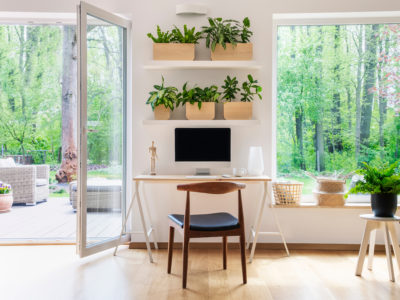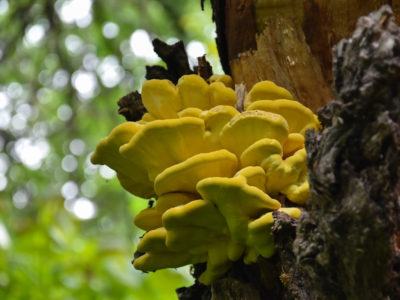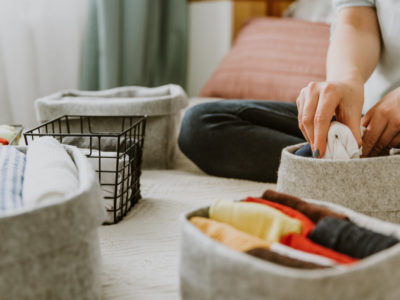Table of Contents[Hide][Show]
Black spots on the bathroom wall…
A musty smell in the laundry hamper…
Fuzzy white spots under the kitchen sink…
Mold has been a concern for decades. Health-conscious people declare that they will never live or work in a building with mold.
But the truth is, they do. We all do. Even right now, wherever you are, chances are you are surrounded by mold spores. You just don’t know it!
So what exactly are these microscopic organisms, and do they deserve their negative reputation?
Let’s head under the microscope to explore the world of mold, why it’s dangerous, and how you can prevent it from growing in your home.
What Is Mold?
Mold is a type of fungi that grows everywhere, both indoors and outdoors. It’s composed of a minuscule multi-cell structure called hyphae. Seen under a microscope, these look like long branches attached to a mold stem (mycelium).
At the end of the hyphae, more mold spores are produced and released. If they land on just the right surface (nutrients, moisture, and temperature), they will grow and begin the reproduction cycle all over again.
The most important element in the growth of mold is moisture. Without it, mold spores will still be present, but mold colonies won’t be able to flourish and spread.
Mold is generally classified into three types.
Allergenic Mold: The most common type of mold. It doesn’t cause any severe illnesses. But if you’re exposed to it, you might experience symptoms similar to a pollen allergy.
Pathogenic Mold: Can cause infections or illnesses, especially in people with a compromised immune system.
Toxic Mold: Will cause a toxic reaction to all who come in contact with it.
Where Does Mold Grow?
Mold grows everywhere and anywhere that it can get its nutrient needs met.
Outdoors, mold grows by landing and feeding on damp, decaying organic matter such as wet fallen leaves. It’s all part of Mother Nature’s cycle.
Mold can also grow indoors in homes, offices, and other buildings. It still needs moisture, which can come from humidity, roof leaks, flood damage, or other sources. And it feeds on cardboard, upholstery, insulation, drywall, and other cellulose materials (organic, plant-based molecules rich in carbon, oxygen, and hydrogen).
How Does Mold Get Indoors?
Mold spores are so tiny that they can enter a room through doorways, air vents, windows, or HVAC units. Mold spores can also be attached to your clothing or footwear or carried in a pet’s fur.
These mold spores aren’t a problem until they fall onto a damp area, at which point they will start to grow.
The Benefits of Mold
One of the most basic facts about mold is also one of the most shocking: mold can actually be beneficial.
That’s right.
Most people think of mold in one of two ways, both of them negative:
- It makes their home look dirty.
- It damages their health.
But mold actually has a very important job: it’s necessary for breaking down dead organic material. The environment needs and wants mold!
Mold can actually kill certain types of harmful bacteria. And in fact, the mold species Penicillium is used to make one of our most potent antibiotics: penicillin.
The Dangers of Mold
So why is mold seen in such a negative light, if it’s necessary?
Property Damage
For one thing, mold can cause severe, irreversible property damage to the material it feeds and grows on.
A mold-riddled carpet, for example, will need to be ripped up and replaced. Mold in the home growing behind walls will require major construction work to remove the mold areas. And papers, including priceless photos or important documents, can be ruined by mold.
Health Issues
Mold can also pose serious health risks.
Due to their small size and light weight, mold spores travel easily through the air. A little too easily, in fact—when mold spores are present in larger numbers, they can aggravate or cause a number of illnesses.
The Most Dangerous Mold
Scientists have already identified over 100,000 mold species, and about 80 of them are harmful to humans. Of these, one of the most dangerous to your health is Stachybotrys Chartarum, commonly known as black mold.
Black mold is one of several species that release a byproduct called mycotoxins. These are created when mold breaks down the material (cardboard, fabric, etc.) that it’s feeding on. If you inhale black mold, it can cause health issues. Infants, children, and people with a compromised immune system are especially susceptible to this “toxic mold.”
Black mold can range in color from dark green to black. Due to its high moisture content, it can also appear to be wet or slick on the surface.
Signs of Mold Exposure
The signs of mold exposure are similar to those of other allergic reactions. You might not even realize that you are reacting to mold, especially if you begin experiencing symptoms during “allergy season.”
Some of the most common signs of mold exposure include:
- Coughing
- Difficulty breathing
- Fatigue
- Headache
- Itching
- Runny nose
- Sneezing
- Watery eyes
- Wheezing
If you have a mold allergy or respiratory illness, such as asthma, your symptoms may be more severe.
If you are exposed to mold repeatedly or for an extended time, your sensitivity will likely increase, causing stronger reactions. The situation is even worse when mold is found indoors or in a poorly ventilated area, since it stays trapped in the air longer and there’s no way to avoid it.
Related
Fight Allergies Through Your Gut
It is almost the end of summer, which means yet another allergy season for some of us. If you find yourself scrambling to find a remedy, it may be time to look within, deep within, as in your gut. I just returned from a two-week trip to Asia and avoided Montezuma’s revenge, aka Bali belly, …
Risk Factors for Mold Issues
Because it’s so tiny that it’s nearly unnoticeable, almost anyone can be exposed to mold. You’ve probably been exposed to mold numerous times!
However, people who live or work in buildings with high moisture and poor ventilation are more likely to exhibit signs of mold exposure.
And certain populations may have a more severe reaction to mold, including:
- Infants and children
- Anyone with a compromised immune system
- People with existing respiratory conditions (such as allergies and asthma)
If you belong to one of those groups and are experiencing allergy symptoms, it’s time to check your environment for mold.
Checking for Mold
Testing for mold can be challenging. Mold counts can vary greatly from day to day, depending on the weather, airflow, and other factors. This can yield inaccurate test results.
For determining whether you have a mold issue, a better and more accurate method than testing is observing. If you can see or smell mold, you need to find the source and eliminate it.
When you’re looking for mold, remember that moisture and mold go hand in hand. Some of the most common places for mold growth include:
- Clothes dryers with indoor vents
- Damp basements or crawl spaces
- Humidifiers
- Plumbing leaks
- Poorly ventilated spaces
- Roofing leaks
- Sites of previous flooding
If you’re looking for mold, keep an eye out for signs such as:
- Dark or discolored spots on walls, grout, carpets, or wallpaper
- Damp areas
- Peeling wallpaper
You may also notice the smell of mold: wet, musty, and stale. If you can smell mold but not see it, it could be a sign that mold is growing someplace not easily visible. It could be under your carpets or behind drywall. A mold professional can conduct an assessment to be sure.
Eliminating Mold
Once you’ve found the source of your mold problem, it’s time to take steps to remove it from your home or office.
This requires a two-pronged approach:
- Clean up any existing mold
- Repair whatever caused the mold
First, clean and remove the mold. If the area with mold growth is smaller than 10 square feet, you can probably do this on your own. Be sure to wear protective gear, such as eyewear, a mask, and gloves. Also, add ventilation either by opening windows and doors, or, if that’s impossible, bringing in a fan.
However, if the mold growth area is larger than 10 square feet, the cleaning job is better left to a mold remediation specialist.
After the area is clean, you need to repair whatever caused your mold issue to ensure that it doesn’t grow back. This could be as simple as adding a dehumidifier. It could also require professional help, such as fixing a leaky pipe. Make sure any and all sources of lingering moisture in the area have been eliminated.
Preventing Mold
Once you’ve eliminated mold and repaired major moisture issues, there are some further steps you can take to prevent mold from growing back.
- Use dehumidifiers in damp rooms, such as the basement
- Make sure high-moisture areas such as the kitchen, laundry room, and bathrooms are well-ventilated
- Keep HVAC drip pans clean
- Choose mold-resistant paint
- Vent clothes dryers to the outdoors
- Consider removing carpets and rugs in high-moisture areas
- Avoid leaving wet clothes in a hamper or washing machine; dry them promptly
Any part of your home that becomes wet or flooded should be dried within 24 to 48 hours. If the job is too big for you on your own, there are water damage specialists who can use industrial fans or other equipment to eliminate moisture. Anything that can’t be completely dried (carpeting, furniture) should be discarded.
Final Thoughts
Let’s do a quick health check. How are your throat, eyes, and nose feeling? If your respiratory health has been feeling more “allergy” than “awesome,” it’s time to look more closely for the cause.
Because those symptoms might not be pollen; they could be caused by mold!
And while it’s impossible to banish mold completely, you can use our strategies above to control its growth by eliminating the environment it loves the most: moisture.
Reducing the amount of mold in your home will reduce your allergy symptoms, too, and have you breathing free and clear in no time!
You May Also Like…

